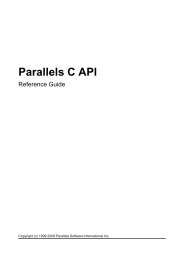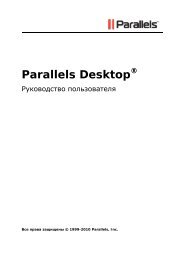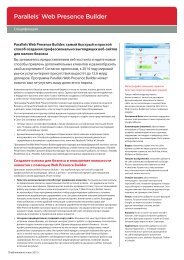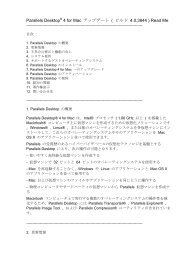[PDF] Parallels Server 5 Bare Metal
[PDF] Parallels Server 5 Bare Metal
[PDF] Parallels Server 5 Bare Metal
Create successful ePaper yourself
Turn your PDF publications into a flip-book with our unique Google optimized e-Paper software.
Listing the Existing Backups<br />
Managing Virtual Machines and Containers<br />
You can use the pctl backup-list command to view the backups existing on the physical<br />
server. For example:<br />
# pctl backup-list<br />
ID Backup_ID Node Date Type Size<br />
{c1dee22f...} {209d54a0...} test.com 2011-05-30 10:19:32 f 411566405<br />
[The ID and Backup ID are reduced for better readability.]<br />
This command lists the backups existing on the Source <strong>Server</strong>. If you want to list the backups on<br />
the Backup <strong>Server</strong>, you need to specify the IP address of this server.<br />
The command output shows that currently only one backup exists on the Source <strong>Server</strong>. This<br />
backup was assigned the ID of c1dee22f-8667-4870-9e11-278f1398eab0 (the full ID is<br />
skipped in the command output). The information on the backup is presented in the following table:<br />
Column Name Description<br />
ID The ID uniquely identifying the virtual machine and Container.<br />
Backup ID The ID assigned to the backup archive. You need to specify this ID when<br />
performing any backup-related operations.<br />
Node The hostname of the physical server storing the backup archive.<br />
Date The date and time when the backup archive was created.<br />
Type The backup type. Currently, you can create two types of backups:<br />
• A full backup indicated by f.<br />
• An incremental backup indicated by i and containing only the<br />
files changed since the previous full or incremental backup. This<br />
is the default backup type.<br />
Size The size of the backup archive, in bytes.<br />
Removing a Virtual Machine and Container Backup<br />
At any time, you can remove a backup that you do not need any more using the pctl backupdelete<br />
command. To do this, you need to specify the ID of the backup to remove and the ID of<br />
the respective virtual machine and Container. If you do not know these IDs, use the pctl<br />
backup-list and check the ID and Backup ID columns. For example:<br />
# pctl backup-list<br />
ID Backup_ID Node Date Type Size<br />
{c1dee22f...} {209d54a0...} test.com 2011-05-30 10:19:32 f 411566405<br />
[The ID and Backup ID are reduced for better readability.]<br />
# pctl backup-delete c1dee22f-8667-4870-9e11-278f1398eab0 -t 209d54a0-e3b8-4a03-9ca8d4cc7a2a27ca<br />
Delete the VM backup<br />
The VM backup has been successfully removed.<br />
You can also specify the virtual machine and Container name instead of its ID:<br />
# pctl backup-delete MyVM -t 209d54a0-e3b8-4a03-9ca8-d4cc7a2a27ca<br />
49


![[PDF] Parallels Server 5 Bare Metal](https://img.yumpu.com/18850617/49/500x640/pdf-parallels-server-5-bare-metal.jpg)
![[PDF] Parallels Desktop® 7](https://img.yumpu.com/18852044/1/190x245/pdf-parallels-desktopr-7.jpg?quality=85)

![[PDF] Parallels Python API Reference](https://img.yumpu.com/18850615/1/190x245/pdf-parallels-python-api-reference.jpg?quality=85)








![[PDF] Parallels Python API Reference](https://img.yumpu.com/18850529/1/190x245/pdf-parallels-python-api-reference.jpg?quality=85)

